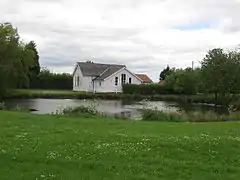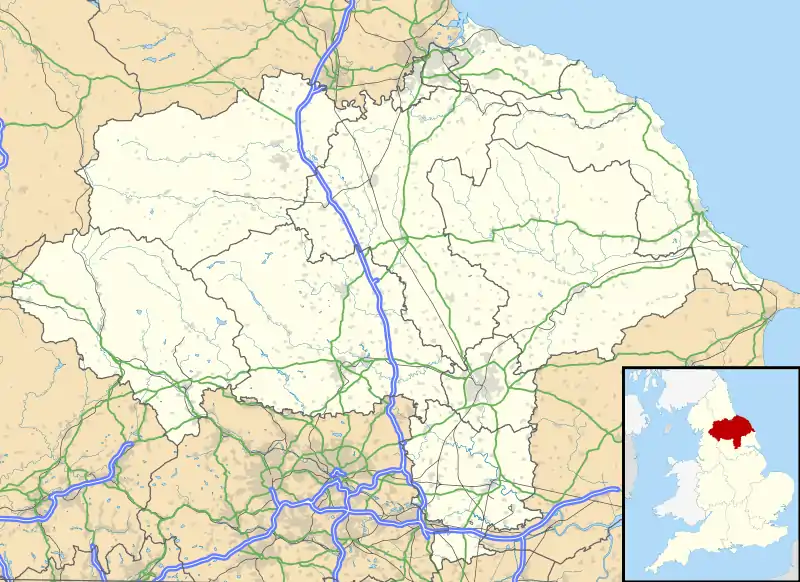Tholthorpe
Tholthorpe is a village and civil parish in the Hambleton district of North Yorkshire, England. It is situated approximately 4 miles (6 km) south-west of Easingwold and 12 miles (19 km) north-west of York.
| Tholthorpe | |
|---|---|
 Tholthorpe Village Hall on The Green | |
 Tholthorpe Location within North Yorkshire | |
| Population | 282 (2011 census)[1] |
| OS grid reference | SE473668 |
| • London | 180 mi (290 km) SSE |
| District | |
| Shire county | |
| Region | |
| Country | England |
| Sovereign state | United Kingdom |
| Post town | Easingwold |
| Postcode district | YO61 |
| Dialling code | 01347 |
| Police | North Yorkshire |
| Fire | North Yorkshire |
| Ambulance | Yorkshire |
| UK Parliament | |
History
The village is mentioned in the Domesday Book as "Turulfestorp" and later as "Thoraldsthorp" and was probably a Viking settlement. The meaning of the name is Norse in origin for the hamlet of Thorald.[2][3]
To the west of the village is Ten Mile Hill, where human remains have been found, probably linked to the battle at nearby Myton in 1319.[4][5]
The remains of a Second World War air force station, RAF Tholthorpe is located nearby. The main units that were stationed there were from No. 6 Group RCAF, including No 77 Sqn; No 420 Sqn; No 425 Sqn No 431 Sqn and No 434 Sqn.[6]
Governance
The village lies within the Thirsk and Malton Parliamentary constituency. It also lies within the Helperby ward of Hambleton District Council and the Easingwold electoral division of North Yorkshire County Council.
Demography
According to the 2001 UK Census, the village has a population of 269 in 88 households. Of the total population, 190 are over 16 years of age, of which 139 are economically active. Of the 88 households, 76 are owner occupied and 67 are detached dwellings.[7]
Geography
The village is north-east of the River Ure covering about 1,700 acres. Derrings Beck flows to the north side of the village and joins Carle Beck to form the River Kyle.[8] The local roads link the village with Raskelf and Helperby to the north, Myton-on-Swale to the west and Flawith and Tollerton to the south east. The East Coast Main Line railway lies 1.5 miles (2.4 km) to the east, though the nearest stations are either York or Thirsk.
The soil varies in different locations around the village. On the west, it is fertile agricultural soil, whilst to the east it is clay and to the north is a mixture of sand and clay.[4]
Village amenities
The village has one public house, the New Inn. There is an industrial park on Moor Lane and a business park on Hag Lane. There is a village hall situated on The Green next to the pond. The village is served by one bus route between Easingwold and York.[9]
References
- UK Census (2011). "Local Area Report – Tholthorpe Parish (1170216941)". Nomis. Office for National Statistics. Retrieved 16 March 2018.
- "Etymology Thorald". Retrieved 21 October 2012.
- "Etymology Thorpe". Retrieved 21 October 2012.
- Bulmer's Topography, History and Directory (Private and Commercial) of North Yorkshire 1890. S&N Publishing. 1890. p. 640. ISBN 1-86150-299-0.
- "Battle of Myton" (PDF). Retrieved 21 October 2012.
- "Airfield". Retrieved 21 October 2012.
- "Demographics=" (PDF). Archived from the original (PDF) on 12 November 2014. Retrieved 21 October 2012.
- "Derrings Beck from Source to River Kyle Overview". environment.data.gov.uk. Retrieved 3 November 2018.
- "Route 29 - York to Easingwold via Linton & Helperby - FROM 3rd SEPTEMBER 2017" (PDF). Stephensons of Easingwold. Retrieved 13 December 2017.
External links
 Media related to Tholthorpe at Wikimedia Commons
Media related to Tholthorpe at Wikimedia Commons